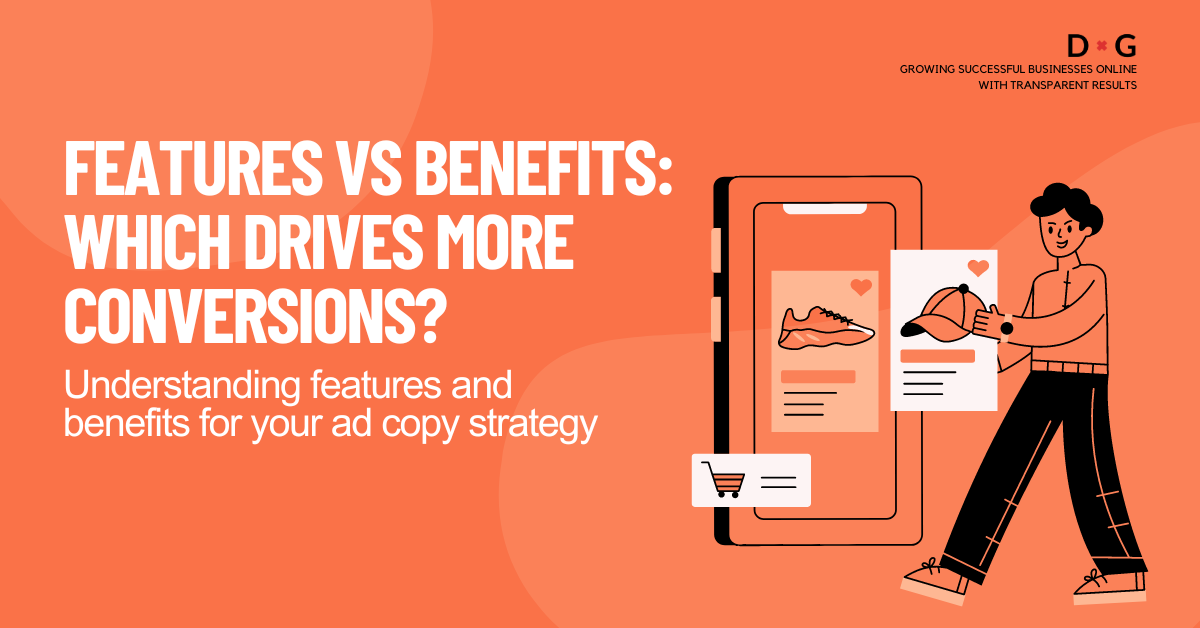
When it comes to advertising copy, knowing the difference between features vs. benefits can greatly enhance your marketing campaign. Some advertisers often use both features and benefits when marketing their products or services. As a business owner considering paid advertising, you might ask yourself whether you should focus on detailing the features of your products or emphasise what the benefits are for the buyer.
Let’s explore why both features and benefits are important and when to use them effectively in your paid advertising copy.
The Difference Between Features and Benefits
Features are the specific parts or functions of a product or service. They are facts about what your product does, its components, or how it is made. For example, a smartphone might have a high-resolution camera, a long-lasting battery, and a sleek design.
Benefits, on the other hand, explain what those features mean for the customer. They turn the technical details into real-life improvements for the customer. Using the same smartphone example, the benefits might be capturing stunning photos with ease, staying connected all day without needing to recharge, and enjoying a stylish device that complements their personal style.
When to Use Features
Using features in your ad copy is important when:
The Target Audience is Technical
When your audience has a deep understanding of the product category and cares about the technical specifications.
Differentiation is Needed
When you need to highlight what sets your product apart from competitors, especially if you have unique or superior features.
Complex Products
For products that are complex or have multiple components, it’s necessary to explain what each part does.
Informed Buyers
When selling to customers who are already knowledgeable and are comparing products based on specific attributes.
When to Use Benefits
Using benefits in your ad copy is crucial when:
Emotional Connection
When you need to create an emotional connection with the audience by showing how the product will improve their lives.
Broad Audience
When your target audience is not highly technical and cares more about the outcome rather than the specifics.
Simplifying the Message
When you need to convey the value of a product in simple terms that are easy to understand.
Highlighting Value
When you want to focus on the value and impact of the product, rather than just what it can do.
Best Examples of Using Features in Marketing
Highlighting features in your marketing can be very effective, especially for audiences who care about technical details and specifications.
Let’s look at some examples of ads that successfully focus on product features.
High-Performance Laptop
Feature-Focused: “Our newest laptop boasts an edge-to-edge display, 10th Gen processors, and a carbon fiber chassis, offering unmatched durability and style.”
Explanation: This ad highlights the technical specifications and design features that make the product stand out, appealing to tech-savvy consumers who value performance and build quality.
4K Ultra HD Television
Feature-Focused: “Immerse yourself in stunning visuals with our 4K Ultra HD TV, featuring advanced color accuracy, motion enhancement, and HDR technology for an unrivaled viewing experience.”
Explanation: This ad emphasises the advanced display technology and features that enhance the viewing experience, targeting consumers looking for top-tier home entertainment systems.
Noice-Cancelling Headphones
Feature-Focused: “Experience superior sound with our noise-cancelling headphones, featuring advanced noise reduction technology, a lightweight design, and up to 20 hours of battery life.”
Explanation: This ad highlights the technical features that contribute to superior sound quality and user experience, appealing to audiophiles and frequent travellers.
Best Examples of Using Benefits in Marketing
Highlighting benefits in your marketing helps create an emotional connection with customers.
Benefits show how a product can improve their lives.
Portable Music Player
Benefit-Focused: “Bring your entire music collection everywhere you go.”
Explanation: This tagline focuses on the benefit of the product, emphasising the convenience of having a large music collection easily accessible at all times.
Running Shoes
Benefit-Focused: “Run faster and longer with our lightweight design, stay cool and comfortable with our breathable mesh upper, and enjoy exceptional support and shock absorption with our cushioned sole.”
Explanation: This ad emphasises the performance benefits of the shoes, appealing to athletes who are looking for ways to enhance their running experience.
Electric Vehicle
Benefit-Focused: “Drive confidently with autopilot, go farther with our long-range battery, and appreciate the sleek, modern design.”
Explanation: This ad highlights the benefits of advanced technology and long-range capability, appealing to consumers interested in innovative and efficient transportation solutions.
Practical Tips for Writing Benefit-Driven Copy
Writing benefit-driven copy can make your ads more persuasive.
Here are some practical tips to help you highlight the benefits of your product and create compelling ad copy.
Know Your Product Inside Out
Understand all the features and what they mean for the user.
Put Yourself in the Customer’s Shoes
Think about how the product or service improves their life.
Use Clear, Simple Language
Avoid using jargon and technical terms that could confuse the reader.
Highlight Unique Selling Points
Emphasise what sets your product apart from the competition.
Include a Call to Action
Encourage the reader to take the next step, whether it’s making a purchase, signing up, or learning more.
Conclusion
In paid advertising, both features and benefits play crucial roles in driving conversions. Features are essential for highlighting the technical aspects and differentiating products, especially for informed and technical audiences. Benefits, on the other hand, create an emotional connection and showcase the real-life impact of the product, making it more relatable and compelling.
The key to a successful advertising campaign lies in understanding your audience, balancing features and benefits, and crafting a message that resonates with potential customers.
You can also check our blog about the best copywriting frameworks for your paid advertising, or contact us today if you need help with your marketing strategy.
